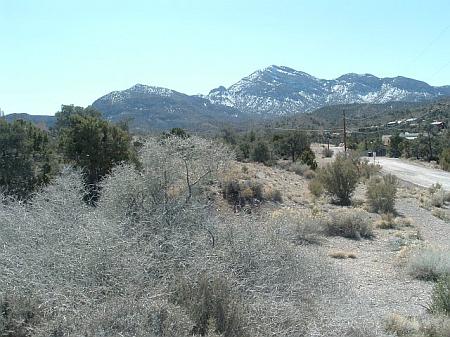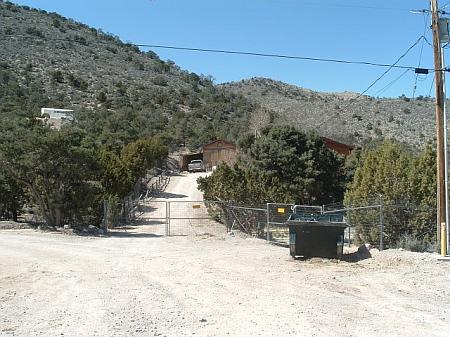8.0 Mt. Springs
8.1 Risk and Hazard Assessment
Mt. Springs is located at the south end of the Spring Mountains approximately thirty miles southwest of Las Vegas. A total of 36 homes were observed in the Mt. Springs area during the hazard assessment, which resulted in classifying Mt. Springs in the Extreme Hazard category (84 points). The rating is primarily attributed to limited access, poor defensible space, the potential for extreme fire behavior, and limited fire protection resources. Table 8-3 at the end of this section presents a summary of the community hazard rating values for Mt. Springs.
8.1.1 Community Design
The area surrounding Mt. Springs is an intermix wildland-urban interface condition. Structures are scattered throughout the wildland area with no clear line of demarcation between wildland fuels, buildings, and open space throughout the community. A majority of the parcels in the community are between one and ten acres in size. The community boundary is shown in Figure 8-1.
- Access: The primary access road into Mt. Springs is State Route 160, a paved two-lane road that is more than 24 feet wide. The road gradient is less than five percent. This is the only primary access road into and out of the community, and many of the secondary roads are dead-end streets without adequate turnaround space for fire suppression equipment.
- Signage: Street signs are visible on all of the roads in the community. Residential addresses are visible on less than 75 percent of the homes in the community. Clear and visible street signs and residential addresses are important to aid firefighters in locating homes during low visibility conditions that may be present during a wildland fire.
- Utilities: There are two types of power lines in Mt. Springs. Power is provided to the homes via above ground lines. There is also a large transmission line supported by wooden poles that runs through the community. This power line is considered to be at risk for damage during a wildfire because the power line corridor is in need of vegetation clearing.
8.1.2 Construction Materials
All of the homes in the interface are built with non-combustible roofing materials and approximately 85 percent of the homes have fire resistant siding materials. Nearly one quarter of the homes in the community (22 percent) have unenclosed balconies, decks, porches, eaves, or attic vents that can create drafty areas where sparks and embers can be trapped, smolder, ignite, and rapidly spread fire to the house.
8.1.3 Defensible Space
Approximately 25 percent of the homes within the Mt. Springs community meet the defensible space requirement for landscaping to minimize damage to the home during a wildfire. The guideline for the minimum defensible space requirement is included in Appendix E.
8.1.4 Suppression Capabilities
Wildfire Protection Resources
The Clark County Fire Department Station 79 in Mt. Springs houses equipment for the twelve member volunteer fire department. Five of these members were reported as holding a Red Card certification that would allow them to participate on a wildfire response with a federal incident command. The station is shared with the seasonal US Forest Service crew. Table 8-1 lists the wildfire resources assigned to the Mt. Springs community. The figures quoted are based on data available at the time of interviews with local and regional fire authorities, and are subject to change.
| Type of Resource | Amount of Equipment | Cooperating Partner (Resource Location) |
|---|---|---|
| Water Tender Type 6 Quick Attack Engine |
1 1 |
Clark County Rural Fire Station 79 (Mt. Springs) |
| Type 3 Brush Engine Type 7 Brush Patrol Engine |
2 1 |
US Forest Service (Mt. Springs Station 79) |
| Source: Steve McClintock, pers. comm., 29 March 2004. | ||
Fire suppression resources administered by federal agencies such as the US Forest Service are listed according to their local assigned area. It is important to note that these apparatus are considered national resources and are commonly reassigned to areas of higher severity during the fire season. In response to a wildland fire call, interagency dispatch centers locate and dispatch the closest available resource according to incident command and computer-aided dispatch protocols.
Water Sources and Infrastructure
Water availability for fire suppression in Mt. Springs include community wells, one 35,000-gallon storage tank, one 10,000-gallon storage tank, ponds, and a 5,000-gallon Fold-a-tank. The water system operates on gravity. Water sources are available within a 20 minute round trip.
Fire Protection Personnel Qualifications
Volunteer and career firefighters who would respond to a wildfire near Mt. Springs have a minimum of NFPA firefighter I and II training and a limited number have had some wildland firefighting training (National Wildfire Coordinating Group 310-1). The Nevada Division of Forestry and US Forest Service personnel meet minimum requirements per NWCG 310-1.
Work Load
The Clark County Fire Department station responded to 98 emergency medical calls and 21 wildland brush fire calls in 2003.
Detection and Communication
There are no fire lookouts in the Mt. Springs area but reconnaissance flights do occur. Communications by the Clark County Fire Department are compatible with neighboring agencies and there are no gaps in the radio coverage. There are no community sirens.
Financial Support
Funding for Clark County Fire Department annual operating expenses comes from the County General Fund, which is generated primarily through property taxes.
Community Preparedness
Clark County has an active Local Emergency Planning Committee and has adopted an all-risk, multi-agency emergency plan. The plan is reviewed annually and updated as needed.
The Clark County Fire Department reviews development plans to ensure compliance with the VFC 1997 fire code.
8.1.5 Factors Affecting Fire Behavior
The vegetative fuel density in the Mt. Springs area is generally heavy throughout the community and slopes range from flat to forty percent. Ground fuels consist of annual grasses, perennial grasses, and Russian thistle. The shrub layer is dominated by bursage (two to three feet tall), fourwing saltbush (four to six feet tall), and four to five foot tall rabbitbrush, mountain mahogany, prickly pear, whitethorn, acacia, cliffrose, and ephedra. The tree layer is dominated by pinyon and juniper, both reaching thirty feet in height. The crowns of the trees touch in many areas. These features combine to result in a high to extreme fuel hazard rating for this community. The community is situated in a saddle area and winds are funneled from the west through the community, topographic conditions that could further exacerbate fire behavior.
8.1.6 Fire Behavior Worst-Case Scenario
The worst-case scenario would occur on a summer afternoon during normal working hours when many volunteer firefighters may not be immediately available. A fire originating south of the community could quickly spread through heavy fuels present in the community. Winds in saddle areas are often very strong. Under windy conditions, a wildfire could quickly escape initial attack capabilities before additional fire suppression resources would have time to arrive.
8.1.7 Ignition Risk Assessment
Mt. Springs has a high ignition risk rating, primarily due to heavy visitor traffic through the area. Annual plants in the understory provide a receptive fuel bed for any ignition that would readily burn into the thick brush and trees.
8.2 Risk and Hazard Reduction Recommendations
The Mt. Springs area is vulnerable to a large fire. Property owners need to take an active role in protecting their property by implementing defensible space treatments, and agencies need to conduct fuels reduction projects. Forming a local chapter of the Nevada Fire Safe Council is an excellent way to begin getting the community oriented on many of the recommendations included below.
8.2.1 Defensible Space
Vegetation density, type of fuel, and slope gradient around a home affect the potential fire exposure levels to the home. These conditions define the defensible space area required for individual homes. The goals of defensible space are to reduce the risk of property loss from wildfire by eliminating flammable vegetation near the home. In turn, this lowers the chances of a wildfire spreading onto adjacent properties and it aids firefighters in their efforts to protect property against an approaching wildfire. Guidelines for establishing and improving defensible space around residences and structures in the community are given below and described in greater detail in Appendix E.
Private Property Owners
- Remove, reduce, and replace vegetation around homes. Keep this area:
- Lean: There are only small amounts of flammable vegetation.
- Clean: There is no accumulation of dead vegetation or other flammable debris.
- Green: Existing plants are healthy and green during the fire season.
- Limb deciduous and coniferous tree branches a minimum of four feet from the ground to reduce ladder fuels. Remove all dead and diseased branches and duff from beneath remaining trees.
- If residents elect to keep some pinyon or juniper trees close to the home for aesthetic reasons, there must not be any other native trees or ladder fuels (shrubs or debris) underneath the trees or within a minimum of thirty feet of the crown of the tree.
- Clear brush, weeds, and grasses from within a ten-foot wide strip along either side of driveways. Remove pinyon and juniper trees and thin ground fuels to a spacing of two times their height. Prune shrubs taller than eighteen inches reduce their height.
- Enclose wood decks and porches. If this is not possible, keep the area beneath wood decks and porches free of weeds and other flammable debris. Where possible, install screens around unenclosed overhangs.
- Clear vegetation and combustible materials from around propane tanks for a minimum of ten feet or twice the height of pinyon and juniper trees, which ever is the greatest distance.
- Clear pine needles, leaves, and debris from roofs and rain gutters.
- Ensure that all branches are at least fifteen feet from chimneys and other heat sources. Install spark arrestors or screens on fireplace and wood stove chimneys.
- Store firewood a minimum of thirty feet from structures.
- Immediately remove all cleared vegetation to an approved disposal site. This material dries quickly and poses a fire risk if left on site.
- Install screens over all exterior vents to prevent sparks from entering the attic and other areas inside the home.
- Create a clearing with a radius of thirty feet around power poles with transformers. Thin or remove brush and all flammable vegetation within this area.
- Maintain defensible space annually.
Clark County Fire Department
- Conduct courtesy inspections of home defensible space measures.
8.2.2 Fuel Reduction Treatments
Recommendations provided below focus on the reduction of fuels along county roadways and the development of fuelbreaks in key locations around the Mt. Springs community. The clearing of fuels along roadways is essential in order to ensure safe ingress and egress for rescue workers, suppression equipment, and residents during a wildland fire event. Because roads and community boundaries can fall under the jurisdiction and responsibility of multiple agencies, cooperation among these parties will be essential in implementing successful and effective fuelbreaks.
A shaded fuelbreak is a fuels reduction treatment that alters the spacing and arrangement of combustible fuels in areas where the current fuel arrangement could support a catastrophic wildfire. If properly maintained, a shaded fuelbreak can eliminate the continuity of fuels in the tree, shrub, and ground layers. As a result, the heat intensity and rate of spread of an oncoming wildfire can be reduced considerably, offering conditions where a fire can be more safely and effectively managed on the ground.
Shaded Fuelbreak and Fuel Reduction Treatment Guidelines
The following specifications apply to fuel reduction treatments in this chapter.
- Broadcast seed in fuelbreak areas prior to fuel removal to enhance soil stabilization and the establishment of fire-resistant vegetation and to prevent noxious weed invasions. Use a pre-suppression seed mixture appropriate for the local climate and soil conditions, such as the one recommended in Appendix E.
- Thin pinyon and juniper trees to a spacing equal to twice their height.
- Thin areas of dense brush so that remaining shrubs have a spacing equal to twice their height between canopies. Further reduce the fuel volume by reducing shrubs to a height of eighteen inches or less.
- Limb tree branches to a minimum of four feet from the ground, not to exceed one-third of the total tree height. Remove dead and diseased tree branches.
- Keep the area within ten feet of limbed trees free of smaller trees, shrubs, duff, and other ladder fuels.
- Where trees are removed, cut stumps as close to the ground as possible, leaving no stump higher than four inches.
- Maintain the shaded fuelbreak, thereby limiting the reinvasion of woody species.
Details and locations for individual features are described below and illustrated in Figure 8-1.
Clark County Fire Department, US Forest Service, Nevada Department of Transportation
- Create a shaded fuelbreak fifty feet in width along each side of Highway 160 from 0.5 miles south of Pinyon, north to Williams Ranch Road where flammable vegetation and topography create the greatest hazard.
- For areas along the east side of Benedict, create a 200-foot wide shaded fuelbreak for the south community boundary from Highway 160 west to the corner and then north again to Highway 160 and along Williams Ranch Road.
Clark County Fire Department
- Work with homeowners to thin fuels for a width of fifty feet along each side of all community roads where homes are present. Within the first 25 feet, remove all pinyon and juniper trees. Within the outer 25 feet, thin trees to a spacing equal to twice the tree height.
- Double these treatment specifications where roads border unimproved lots. Establish a 100-foot fuelbreak by removing all trees for the first fifty feet and thinning to a spacing of two times the tree height for the remaining fifty feet.
Utility Company
- Clear the vegetation surrounding electrical transfer stations within thirty feet of the fence.
- Remove all trees from beneath transmission lines. Trim brush to eighteen inches tall and thin to a distance two times shrub height.
8.2.3 Community Coordination
Private Property Owners
- Form a local chapter of the Nevada Fire Safe Council. The Nevada Fire Safe Council facilitates solutions to reduce the loss of lives and property from the threat of wildfire in Nevada’s communities. Through the establishment of a local Chapter, communities will become part of a large network for sharing information and notification of programs and funding opportunities for fire mitigation projects such as those listed in this report. The Nevada Fire Safe Council will accept and manage grants and contracts on the Chapter’s behalf through its non-profit status. The Nevada Fire Safe Council will provide assistance and support to communities to complete fire safe plans, set priorities, educate and train community members, and promote success stories of its members. To form a local Chapter or for more information contact the:
Nevada Fire Safe Council
1187 Charles Drive
Reno, Nevada 89509
www.nvfsc.org - Make sure residential addresses are visible from the road. Address characters should be at least four inches high and reflective. Improving visibility of addresses will make it easier for those unfamiliar with the area to navigate an area during a wildland fire.
- Work with the Clark County Fire Department and Sheriff’s Department to identify any non-ambulatory persons within the community who may need evacuation assistance in the event of an emergency.
Clark County
Coordination among local, state and federal fire suppression agencies is important in the day-to-day fire prevention activities and becomes critical in the event of a wildland fire. The goal of community coordination is to make the entire community fire safe.
- Develop and enforce brush clearance and biomass disposal programs as a component of the fuelbreak and defensible space recommendations above.
- Allow backyard open burning only under a permit process or establish designated community burning days.
- Ensure cooperation between the Assessor’s Office and the Roads Department to ensure that all new development roads are named, mapped, and identified with GPS locations.
8.2.4 Public Education
Public education is an important tool to engage public participation in making a community fire safe. Informed community members will take the initiative required to lead efforts of a scale that will effectively reduce the threat that wildland fires present to the entire interface community.
Clark County Fire Department
- Distribute copies of the publication “Living with Fire” to all property owners. This publication is free of charge. Copies can be requested from the University of Nevada Cooperative Extension.
- Develop public education materials on the wildland fire dangers of fireworks.
- Hold an annual community fire awareness event in cooperation with the local fire Safe Council Chapter.
8.2.5 Fire Suppression Resources and Training
Clark County Fire Department
- Comply with minimum standards regarding training and personal protective equipment for all firefighters in accordance with the Wildland and Prescribed Fire Qualification System Guide PMS 310-1. (See Section 4.2 of this report for a description of these standards).
- Establish and publicize a safe zone, such as the fire station, where people can safely gather during a wildfire event or other emergency.
- Install a community siren as a communication tool for evacuation.
- Develop a helicopter dip site for use during initial attack such as ponds, tanks, etc. Wells or existing springs can be used to develop dip sites for use during the summer. Initial attack will be critical for the Mt. Springs area.
- Move additional resources into the area on high hazard days, if available, or ensure volunteer resources are adequate for high hazard days.
- Investigate the purchase of a fire blocking gel or foam that can be applied to structures and to vegetation in order to create an additional layer of fire protection.
8.3 Summary of Recommendations
| Involved Party | Recommended Treatment | Recommendation Description |
|---|---|---|
| Property Owners | Defensible Space | Apply and maintain aggressive defensible space treatments according to the guidelines in Appendix E. |
| Community Coordination | Ensure that address signs are clearly visible from the road. Form a local chapter of the Nevada Fire Safe Council. |
|
| Property Owners Clark County Fire Department |
Fuels Reduction | Thin fuels along all community roads according to standard shaded fuelbreak guidelines. |
| Clark County Fire Department | Defensible Space | Conduct courtesy inspections of defensible space condition and defensible space treatments on private property. |
| Fire Suppression Resources and Training | Comply with NWCG 310-1 training and equipment standards. Develop and publicize a fire safe zone where residents can gather during a wildfire. Install a community siren to advise residents of evacuation orders. Strengthen initial attack capabilities by developing helicopter dip sites and requesting the placement of additional resources in the region during high hazard days. Investigate the purchase and use of fire blocking foams and gels for additional structure protection in the wildland-urban interface. |
|
| Public Education | Distribute copies of “Living with Fire” to all property owners living in Lee Canyon. Develop an annual community fire awareness event and educational materials that highlight the wildland fire dangers of fireworks. Contact NDF, the USFS, and the University of Nevada Cooperative Extension for assistance with public education activities. |
|
|
US Forest Service Nevada Department of Transportation Clark County Fire Department Clark County |
Fuels Reduction | Construct and maintain shaded fuelbreaks:
|
| Community Coordination | Develop county ordinances that enforce the implementation and maintenance of defensible space. Develop regular brush clearance, biomass disposal, and open burn permitting programs. Ensure cooperation between the Assessor’s Office and the Roads Department so that all roads in new developments are named, signed, mapped, and identified with GPS locations. |
|
| Utility Company | Fuels Reduction | Remove trees within overhead utilities corridors;
completely remove all vegetation within fifteen feet of utility poles. Clear all vegetation surrounding electrical transfer stations. |
Table 8-3. Mt. Springs Fire Hazard Ratings Summary |
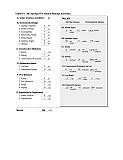 |
Figure 8-1 Mt. Springs Fire History, Suppression Resources, and Proposed Mitigation Projects |
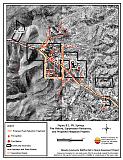 |
Figure 8-2 Mt. Springs Fuel Hazard Classification |
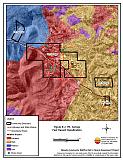 |
Figure 8-3 Mt. Springs Fuel Hazard Photo Points
Photo Point 1. 3987366 N. 0634387 E. Direction 180°S. The typical extreme fuel hazard on the west side of Mt. Springs is dominated by pinyon and juniper that will burn with sufficient intensity to damage power poles and overhead lines. Homeowners and utility managers are recommended to remove trees within power line corridors. A thirty-foot cleared area is recommended around transformers.
Photo Point 2. 3987262 N. 0634793 E. Direction 120°ESE. Fuel reduction treatment on this site will protect residences in the north part of Mt. Springs from wildfires encroaching from the west. Fuels here consist primarily of sagebrush, fourwing saltbush, rabbitbrush, pinyon, and juniper and were considered an extreme fuel hazard.
Photo Point 3. 3986804 N. 0634486 E. Direction 270°W. Homeowners with properties in high fuel hazard areas such as this are recommended to thin fuels for a width of twenty feet along each side of driveways. Pinyon and juniper trees should be removed and ground fuels thinned to a spacing of two times their height.


